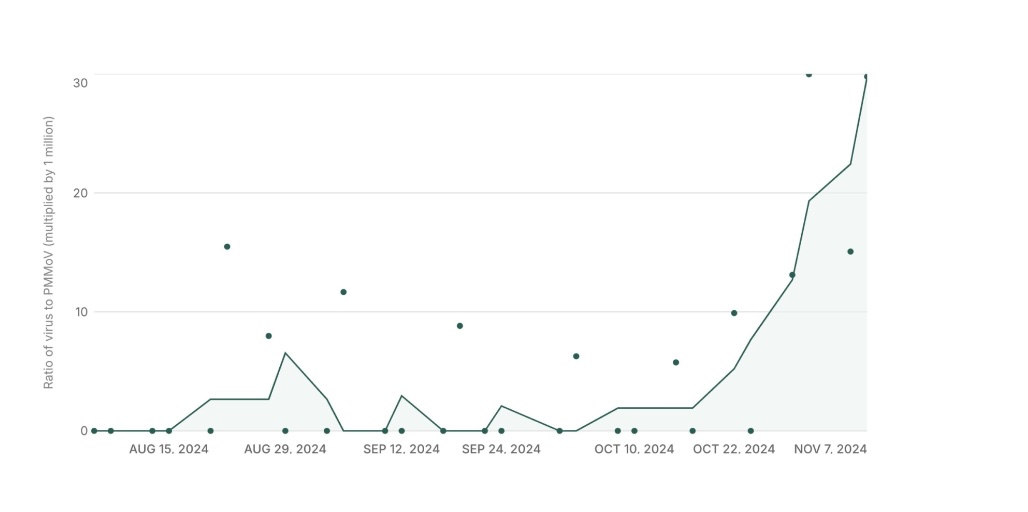|
Getting your Trinity Audio player ready...
|
OWN VOICE. ~ InPerspective by Bruce Laird, with Gregg Dieguez —
Not So Fast. “To use the vernacular: Things are getting better; but baby it’s not over yet. Those who are getting mild or asymptomatic infections are creating more variants and spreading those variants – making things worse for the rest of the country.”
– Dr. Jorge Rodriguez, on CNN, 8 Feb 2021
Footnotes: to use, click the bracketed number and then click your browser Back button to return to the text where you were reading. Images: most will enlarge for improved readability in a new window when you click on them.
After I get vaccinated, I will continue the Public Health mitigation behaviors that have kept me and my family safe so far (mask wearing, social distancing, minimizing dwell time in public indoor settings, hand washing). I plan to keep this up until I see that daily new cases in my county and surrounding counties have dropped to zero and remained there for at least two weeks. Taking into account the slowing pace of new infections, the increasing rate at which we are vaccinating people, but also the degree of vaccine hesitancy in the general population, I am guessing that I’ll need to keep this up until at least the fall of 2021.
Here are some reasons to remain cautious, even after two vaccine doses plus ‘burn-in time’:
1. A ‘breakthrough’ COVID case rate of between 3% and 10% among mRNA vaccinees.
2. The current SARS-2 vaccines are not proven to provide sterilizing immunity.
3. Long COVID consequences following even a mild infection.
4. Efficacy against new viral variants is uncertain at this time.
This article covers concerns 1 -3; an article addressing variants is coming soon. . .
In addition, modeling safe Public Health behaviors around those who are still waiting to get vaccinated seems like a good idea. As more and more of us get vaccinated, if we start acting like it’s suddenly a lot safer, we may encourage unvaccinated people to stop protective behaviors, maybe even drop out of the vaccination queue, and start putting themselves and their families at unnecessary risk. And the more people who get infected, the more chances the virus has to mutate into more deadly strains. After two doses I will likely be protected from severe COVID; but it has not yet been proven that I will not unwittingly be capable of transmitting it to others. Consider that if I do end up contracting a ‘breakthrough’ case, it is very likely to be mild for me. I may even be asymptomatic, but I may still be capable of transmitting virus to unvaccinated friends, younger relatives, and the community.
This article[*] reviews what the science to date is telling us about these important topics:
1. Breakthrough infections
2. The spectrum of Immunity
3. Long COVID studies
1. Breakthrough infections
None of the SARS-2 vaccines is 100% protective, although there is evidence that they are approaching 100% protective against severe COVID. If you need some real world examples of breakthrough infections, here are a few:
A. Oregon Public Health officials reported recently that four Oregonians have tested positive for COVID, despite having received dose #2 of vaccine at least 14 days prior. [1]
B. Back in late January, two Massachusetts representatives to the U.S. Congress announced that they had both tested Positive after receiving vaccinations. [2]
From the article: “Public health experts have emphasized that it usually takes one week after the second dose of the Pfizer-BioNTech vaccine to reach 95 percent efficacy and two weeks after the second dose of the Moderna vaccine to reach 94 percent efficacy.” But what does that mean? [According to] Onyema Ogbuagu, the principal investigator for Pfizer’s vaccine trial at Yale University, “On a population level, 95% efficacy still translates to 5/100, or 50/1,000, or 500/10,000 vaccinated persons still being vulnerable to symptomatic disease and maybe even more having asymptomatic carriage.”
Would you believe a weather forecast that tomorrow’s temperature will be 67.298°? No, you’d believe a RANGE of temperatures forecast. Same thing with vaccines. Of course Dr. Obuagu is trying to keep things simple, and he is actually being generous, in two ways: First, 95% is a point estimate of the efficacy of Pfizer’s vaccine, based on clinical trial (CT) data. A more accurate statement is that, with 95% confidence, Pfizer has demonstrated efficacy that lies between 90% and 97.6%. For Moderna, the demonstrated confidence interval is 89.1% to 96.8%. We should not be surprised if we see anywhere between 2% and 11% of vaccinated people contracting breakthrough infections. This would be within the limits of what we could expect from the clinical trial data for these two vaccines, and this efficacy is before we start to talk about what mutant variants of the virus could lead to.
Further, these efficacy estimates are based on data observed in CTs, where best practices were ensured by the vaccine manufacturers (quality control; maintenance of cold chain during shipping and storage; well-trained staff giving shots with proper procedures and timing). So these are probably ‘best case’ estimates. As the general public receives these vaccines, there will be deviations from optimal administration, for various reasons. The result will be a de facto observational study of vaccine effectiveness, which we should expect to be less than published clinical trial efficacies. How much less? We don’t know yet.
2. The spectrum of Immunity
Immunity is not a binary on/off switch, and not absolute. It’s a spectrum of protection that can vary in strength from person to person, and wanes over time in each of us. It is a measure of how effectively your immune system can prevent replication of the virus in your body. Immunologists divide that spectrum into four categories:
1. protection against severe symptoms
2. protection against any symptoms
3. protection against transmission to others
4. protection against infection
The gold standard for vaccine developers is sterilizing immunity, where protection is provided not only against severe disease symptoms, but also against transmission to others. As an example, after thousands of years smallpox was officially eliminated from the human population in 1980, because vaccines were developed that achieved sterilizing immunity.
“Although many vaccines widely used today (against measles, for example) produce very effective sterilizing immunity, others, such as the hepatitis B vaccine, do not. With these vaccines, an individual’s immune system is trained to prevent illness, yet the pathogen can persist in that person’s body, potentially allowing them to infect others. A lack of sterilizing immunity means that the pathogen can continue to circulate in a population, where it may cause illness in unvaccinated and vulnerable people or evolve to evade our immune responses.[3]
The current crop of COVID vaccines have demonstrated very high efficacy against disease symptoms, but we still don’t know if they can provide sterilizing immunity, mainly because the safety and efficacy clinical trials were not designed to measure viral transmission. Blocking transmission of a respiratory virus like SARS-2 is difficult, because it requires that the immune system stop the virus from replicating not only in the lungs, gut, and blood vessels, but also in nasal passages and the throat, areas where antibodies and killer T cells have a harder time reaching and disabling virions and infected cells.
Bottom line? Until we reach sterilizing immunity we may have this virus with us every year, but to a hopefully less fatal degree.[4]
3. Long COVID studies
It is widely recognized that long COVID is real, and that after a COVID patient has cleared the virus, long haul symptoms can persist for many months and maybe years (we don’t know how long.) [5][6]
Long COVID symptoms commonly reported include: fatigue, difficulty breathing, sleep disruption, and ongoing problems with sense of smell or taste. Neurological symptoms including depression, memory loss, and difficulty with thinking or concentration (“brain fog”) are also reported. In severe COVID cases, organ damage has been noted both clinically and via autopsies, including: heart (myocarditis), lung, kidney, GI tract and vascular damage; and most recently blockage of capillaries in the brain (see below) that may explain some of the neurological problems.
Early studies [7] of the 2-3 month-after effects of COVID among recovered patients focused mainly on those who had been hospitalized, some with severe disease. Now we also have results from a study that followed people with mild disease courses, most of whom were treated on an outpatient basis. [8] These individuals experienced some of the same lingering long COVID symptoms seen in more severe COVID cases, albeit less disabling (see footnotes).
If you have had even a relatively mild COVID infection, this study has important implications for your long term health surveillance plan. And if you are unfortunate enough to be vaccinated but still wind up with a mild breakthrough case, this may apply to you as well. You might want to be more watchful for signs of myocarditis, and lung, kidney and vascular issues.
Previous studies like the ones above have not shown strong evidence that the virus crosses the blood-brain barrier to infect brain tissue, yet COVID survivors frequently report feeling brain fog, or other forms of cognitive impairment. Now there is some evidence for a previously unsuspected mechanism that may lead to damage to the brain: megakaryocytes blocking blood flow in brain capillaries. The evidence is from autopsies of brains of patients who died from (presumably severe) COVID, so it’s not clear if this occurs in milder cases.[9]
Finally, there is alarming new evidence in a recent study of COVID patients done by a team at the University of Washington which is the first study to follow for up to 9 months, a cohort of mostly outpatient COVID cases, 90% of whom had only a mild COVID illness, yet one third continued to have lingering effects. [10] Per that study: “With 57.8 million cases worldwide, even a small incidence of long-term debility could have enormous health and economic consequences.”
In summary, even a mild case of COVID can have long-lasting negative consequences for your health. My advice is to continue to avoid risky behaviors, even after vaccination, until the point when daily new cases in your geographic area have dropped to darn near zero, and remained there for days to weeks. Stay safe out there!
FOOTNOTES:
[*] There’s More…
This article is based on update #101 of Bruce’s ongoing series on COVID-19.
[1] ‘Breakthrough’ COVID infections:
See: Erin Ross, “4 Oregonians test positive for COVID-19 despite being vaccinated.” Oregon Public Broadcasting, 12 Feb 2021.
From the article:
These re-infections, called “breakthrough infections,” are infections that occur more than 14 days after receiving the second dose of vaccine. Given the effectiveness rate of the two vaccines —95% for both Pfizer-BioNTech’s and Moderna’s — it’s inevitable that some of the 177,000 vaccinated Oregonians would become reinfected.
It isn’t yet known if these four known reinfection cases involved newer variants of the coronavirus. The Oregon Health Authority is attempting to get samples from these patients to be tested. The Centers for Disease Control and Prevention is gathering data on COVID-19 breakthrough cases, but they have yet to make that data public. Oregon is one of the first states to participate in their genomics surveillance program, and has sent information about these cases to the CDC.
Many breakthrough cases were reported during the Moderna and Pfizer COVID-19 vaccination trials. Those cases tended to be asymptomatic or mild, and so far, Oregon’s cases fall into either of those two categories.
The CDC’s SPHERES program for genomic testing to study variants and vaccine breakthrough cases, alluded to above, is described in more detail on p. 92 of this article: Summer Galloway, et al, “Emergence of SARS-CoV-2 B.1.1.7 Lineage — United States, December 29, 2020–January 12, 2021.” CDC Morbidity and Mortality Weekly Report, Vol. 70, No. 3, 22Jan 2021.
[2] More Breakthrough Infections:
Amy B Wang and Sarah Kaplan, “Two lawmakers test positive for coronavirus, one after receiving both doses of vaccine.” WaPo, 30 Jan 2021. Rep. Lori Trahan received her first dose of one of the vaccines on an unspecified day during the week of 18-22 Jan. She tested Positive on 28 Jan, so probably got infected between 1-5 days after the shot. Perhaps not that surprising, so close after just the first dose. Then there was Rep. Stephen Lynch, who tested positive on 29 Jan. Lynch received a second dose of the Pfizer vaccine, an undisclosed number of days prior to the 20 Jan inauguration ceremony. He also tested Neg before attending the event, so he likely became infected no less than 1 day, and perhaps up to 7-8 days after his second dose.
[3]
Sterilizing Immunity
Stacey McKenna, “Vaccines Need Not Completely Stop COVID Transmission to Curb the Pandemic.” Scientific American, 18 Jan 2021. Also from that article: Sterilizing immunity may have been a lofty goal for COVID-19 vaccine manufacturers, though not necessary to curb disease. According to [Natasha Crowcroft, senior technical adviser for measles and rubella at the World Health Organization], the very concept of such immunity is nuanced. “In reality, the spectrum of protection might best be framed as the extent to which vaccination prevents transmission of the wild-type virus or bacteria.”
[4]
Here is another good article on vaccination and herd immunity: Sarah Zhang, “What If We Never Reach Herd Immunity?” The Atlantic, 9 Feb 2021.
From the article:
Most of the topline efficacy numbers for vaccines are against symptoms; to prevent transmission, though, which is key for herd immunity, the vaccine needs to tamp down viral replication even further. That’s why vaccine efficacy against transmission is expected to be lower than efficacy against symptoms—exactly how much lower is still unclear.
Efficacy against transmission will probably be the first to erode too. In the long term, immunity in general tends to wane, with protection against severe disease being the most durable. New variants may further knock vaccine efficacy down a rung or two. A vaccine that might have protected a recipient from getting infected with the original virus might now protect only against symptomatic infection. That’s still good for the vaccine recipient but not so good for herd immunity: The recipient could now carry enough virus to asymptomatically transmit it to others.
This pattern has biological explanations. First, the location of immunity matters. Respiratory viruses such as the coronavirus infect through the nose and throat, but current COVID-19 vaccines are all given as shots into arm muscle. These vaccines elicit a strong immune response and high levels of antibodies, also known as titers, inside the body—but not necessarily in the mucous membranes of the nose and throat, which are the first line of defense against the coronavirus. “It’s possible that over time, as titers fall away, you start to get infections in the upper respiratory tract,” says Jason McLellan, a biochemist at the University of Texas at Austin. “Hopefully you’re still protected in the lower respiratory tract, preventing pneumonia, the severe disease, and the hospitalization.”
What does that mean for the future of COVID-19? One possible scenario is that the disease could follow the path of the four coronaviruses that cause common colds, which frequently reinfect people but rarely seriously. In one study that tried to infect and then reinfect volunteers with one of these common-cold coronaviruses one year apart, some of the volunteers indeed got reinfected but without symptoms. They also had detectable amounts of the virus in their nose for a shorter period of time. For COVID-19, “the optimistic future is that there are still infections but they are less frequent than now,” Jesse Bloom, a virologist at the Fred Hutchinson Cancer Research Center, wrote in an email, “and most infected people have something more resembling a cold than a life-threatening infection.”
[5]
Long Haul COVID-19
For a quick summary, see: “COVID-19 (coronavirus): Long-term effects,” written by Mayo Clinic Staff.
[6]
More on Long Haul COVID-19
Also see: “Understanding the Long-Term Effects of COVID-19.” Brigham and Women’s Hospital.
[7] Long Haul COVID after Hospitalization
Here is an example of one of the early studies, done with 120 patients who were hospitalized, treated, discharged, and then surveyed an average of 111 days after hospital admission. Eve Garrigues, et al, “Post-discharge persistent symptoms and health-related quality of life after hospitalization for COVID-19.” Journal of Infection, 24 Aug, 2020.
From the paper:
The most frequently reported persistent symptoms were fatigue (55%), dyspnea [difficulty breathing] (42%), loss of memory (34%), concentration and sleep disorders (28% and 30.8%, respectively). Most patients requiring hospitalization for COVID-19 still have persistent symptoms. While there were few differences between HRQ0L [Health Related Quality of Life] between ward and ICU patients, our findings must be confirmed in larger cohorts, including more severe patients.
[8] Organ Damage from Mild COVID
Another example is: Andrea Dennis, et al, “Multi-organ impairment in low-risk individuals with long COVID.” medRxiv, 16 Oct 2020.
This article describes a longitudinal study of 201 individuals who were followed between April and September 2020. Assessments were completed between 105 and 160 days after recovery from COVID.
From the article:
Symptoms and organ function (heart, lungs, kidneys, liver, pancreas, spleen) were assessed by standardised questionnaires, blood investigations and quantitative magnetic resonance imaging, defining single and multi-organ impairment by consensus definitions.
The prevalence of pre-existing conditions (obesity: 20%, hypertension: 6%; diabetes: 2%; heart disease: 4%) was low, and only 18% of individuals had been hospitalised with COVID-19. Fatigue (98%), muscle aches (88%), breathlessness (87%), and headaches (83%) were the most frequently reported symptoms. Ongoing cardiorespiratory (92%) and gastrointestinal (73%) symptoms were common, and 42% of individuals had ten or more symptoms.
There was evidence of mild organ impairment in heart (32%), lungs (33%), kidneys (12%), liver (10%), pancreas (17%), and spleen (6%). Single (66%) and multi-organ (25%) impairment was observed, and was significantly associated with risk of prior COVID-19 hospitalisation (p<0.05).
[9]
Cause of Brain Damage from COVID-19
A team headed by Dr. David W. Nauen, of the Dept. of Pathology at Johns Hopkins, has published results from 17 brain autopsies: 15 from COVID patients, and 2 from uninfected control patients. They report finding megakaryocytes blocking brain capillaries in 5 of the COVID patients, none in the 2 uninfected patients. Very small N, but see: David Nauen, et al, “Assessing Brain Capillaries in Coronavirus Disease 2019.” JAMA Neurology, 12 Feb 2021.
From the paper:
Evidence suggests brain involvement in coronavirus disease 2019 (COVID-19). Manifestations in acutely ill individuals often include confusion and alteration of consciousness. After this phase, many patients experience continued neurologic symptoms such as dysexecutive syndrome1 or “brain fog.” However, in autopsies from patients with COVID-19 who had neurologic abnormalities (reviewed in the study by Mukerji and Solomon), investigations have largely not identified the chronic inflammation or marked neural changes typically associated with viral infection, and viral genetic material has been minimal or absent. It has been difficult to reconcile the experience of patients and clinicians that COVID-19 is altering cognition with tissue studies that show no evidence of encephalitis involving higher brain centers. We hypothesized that histopathology might provide insight. We report here a finding that may contribute in some cases, identified by analysis of brain tissue from patients who died of COVID-19.
Prior to this pandemic, the study neuropathologists (D.W.N. and I.H.S.) had not seen megakaryocytes in brain vessels, and we find no reference to this in the literature. A recent report showed these cells in an infarcted brain in COVID-19, suggesting they could have been present in the brain circulation and entered the parenchyma during hemorrhage.
In 5 [COVID] cases in cortical capillaries, we identified large cell nuclei morphologically consistent with megakaryocytes (Figure, A). To further characterize these cells, we performed immunohistochemistry for CD61 and CD42b, markers of platelets and megakaryocytes. CD61 labels these cells (Figure, B), as does CD42b (Figure, C), confirming their megakaryocyte identity. The cells were distinct from platelet clusters, which were found in postmortem intravascular precipitates (Figure, D). Evaluation of the cortex of 2 patients who tested negative for COVID-19 who had hypoxic brain changes demonstrated no megakaryocytes on CD61.
Multiple lines of evidence indicate endothelial dysfunction may contribute to severe COVID-19 illness. Lung examination demonstrates megakaryocytes, and the cells have now been reported in other organs.6 One possibility is that altered endothelial or other signaling is recruiting megakaryocytes into the circulation and somehow permitting them to pass through the lungs. Although this initial study does not investigate mechanism, it is notable that we found megakaryocytes in cortical capillaries in 33% of cases examined. Because the standard brain autopsy sections taken sampled at random only a minute portion of the cortical volume, finding these cells suggests the total burden could be considerable. By occluding flow through individual capillaries, these large cells could cause ischemic alteration in a distinct pattern, potentially resulting in an atypical form of neurologic impairment.
[10]
A third of mild COVID cases have long term damage…
See: Jennifer Logue, Nicholas Franko, Denise McCulloch, Helen Chu, et al, “Sequelae in Adults at 6 Months After COVID-19 Infection.” JAMA Network Research Letter, 19 Feb 2021.
From the research letter:
In this cohort of individuals with COVID-19 who were followed up for as long as 9 months after illness, approximately 30% reported persistent symptoms. A unique aspect of our cohort is the high proportion of outpatients with mild disease. Persistent symptoms were reported by one-third of outpatients in our study, consistent with a previously reported study, in which 36% of outpatients had not returned to baseline health by 14 to 21 days following infection. However, this has not been previously described 9 months after infection.
Consistent with existing literature, fatigue was the most commonly reported symptom. This occurred in 14% of individuals in this study, lower than the 53% to 71% reported in cohorts of hospitalized patients, likely reflecting the lower acuity of illness in our cohort. Furthermore, impairment in HRQoL [Health-Related Quality of Life] has previously been reported among hospitalized patients who have recovered from COVID-19; we found 29% of outpatients reported worsened HRQoL.
Notably, 14 participants, including 9 nonhospitalized individuals, reported negative impacts on ADLs [Activities of Daily Living] after infection. With 57.8 million cases worldwide, even a small incidence of long-term debility could have enormous health and economic consequences.
Study limitations include a small sample size, single study location, potential bias from self-reported symptoms during illness episode, and loss to follow-up of 57 participants. To our knowledge, this study presents the longest follow-up symptom assessment after COVID-19 infection. Our research indicates that the health consequences of COVID-19 extend far beyond acute infection, even among those who experience mild illness.
More From Gregg Dieguez ~ “InPerspective”
 Mr. Dieguez is a native San Franciscan, longtime San Mateo County resident, and semi-retired entrepreneur who causes occasional controversy on the Coastside. He is a member of the MCC, but his opinions here are his own, and not those of the Council. He lives in Montara. He loves a productive dialog in search of shared understanding.
Mr. Dieguez is a native San Franciscan, longtime San Mateo County resident, and semi-retired entrepreneur who causes occasional controversy on the Coastside. He is a member of the MCC, but his opinions here are his own, and not those of the Council. He lives in Montara. He loves a productive dialog in search of shared understanding.

<< Mr. Laird is another semi-successful, semi-retired MIT entrepreneur but with more degrees, living in Los Altos. They roomed and caused trouble together back in the day. Bruce produces a periodic newsletter on the science and implications of COVID-19. For a free subscription, contact Bruce at: laird2007@hotmail.com





